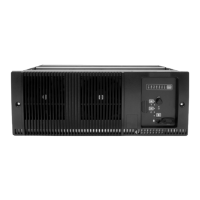TB9100/P25 CG/P25 TAG Installation and Operation Manual Installation 69
© Tait Limited March 2014
Connecting RF
Notice Do not remove the load from the PA while it is transmitting.
The RF input to the base station is via the lower BNC/TNC connector on
the rear panel of the reciter. The RF output is via the N-type connector on
the rear panel of the PA (refer to Figure 3.8 on page 64).
We recommend that you use dual-screened coaxial cable such as RG223 for
the BNC/TNC connections, and RG214 for the N-type connections.
Protecting the PA While the PA is protected against damage if it is keyed while connected to
a mismatched load, it is not protected against load transients (switching or
removing the load) while transmitting or atmospheric disturbances (for
example, electrical storms). We recommend the following installation
procedures, which should protect the PA from damage under all but the
most extreme operating conditions.
1. Do not connect the PA directly to the antenna. Fit an isolator or cav-
ity filter (for example, a duplexer) between the PA and the load.
Fit the isolator as close as possible to the RF output connector on the
PA. Do not connect any switching equipment between the isolator
and the PA, unless the switch cannot operate while there is RF pres-
ent (i.e. the base station is transmitting).
2. Fit a surge suppressor to the antenna cabling where it enters the
building.
3. Inspect all cables and equipment connected to the base station for
defects.
Ice on the antenna, or a broken antenna, is unlikely to cause damage to the
PA.
Explanation Most base station manufacturers have adopted 28V LDMOS technology to
benefit from its superb wide-band performance and high efficiency.
Accordingly, the 50W and 100W PAs use an LDMOS FET as the final
power device. The circuit design of these PAs protects the FET from high
VSWR. This makes it difficult to damage the device by keying the PA into
a mismatched load, or if the load deteriorates over even a short period of
time (milliseconds).
Figure 3.12 Auxiliary DC power connector
Phoenix MVSTBR2.5HC/2-ST/5.08 female

